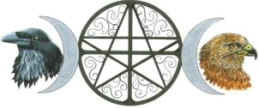Many of the Imbolc celebrations and customs involve honoring the Goddess Brighid. In later years the Catholic celebration of Candlemas still honors Brighid. She evolves into St. Brigit. There are several references to St Brigit of Ireland or Brigit of Kildare. For this article I will stick with Brigid [also known as Brìghde/Bride in Scotland].
In Irish mythological cycles, Brighid (or Brighit), whose name is derived from the Celtic brig or “exalted one”, is the daughter of the Dagda, and therefore one of the Tuatha de Dannan. Her two sisters were also called Brighid, and were associated with healing and crafts. The three Brighids were typically treated as three aspects of a single deity, making her a classic Celtic triple goddess. She was the wife of Bres of the Fomorians, with whom she had a son, Ruadán.
Brigid is considered the patroness of poetry, smithing, medicine, arts and crafts, cattle and other livestock, and spring. Along with these attributes, she also is associated with the element of fire. Any type of fire symbolism, including light, candles, illumination, heat, warmth or sunrises also belong to this goddess. Arrows, bells, thresholds and doorways are also included in Brigid symbolism. Several animal correspondences are also tied to Brigid, particularly ewe, dairy cows, bees, owls and serpents.
As you can see Brigid/Brighid/Brigit plays a large role in the Celtic Pantheon. She was deeply entrenched in the hearts and minds of the Celts. She is the goddess of all things perceived to be of relatively high dimensions such as high-rising flames, highlands, hill-forts and upland areas; and of activities and states conceived as psychologically lofty and elevated, such as wisdom, excellence, perfection, high intelligence, poetic eloquence, craftsmanship, especially blacksmithing, healing ability, druidic knowledge and skill in warfare. In the living traditions, whether seen as goddess or saint, she is largely associated with the home and hearth and is a favorite of both Pagans and Catholics.



